At Woodlands Academy
Woodlands Academy is committed to safeguarding and promoting the welfare of children by:
All action taken by Woodlands Academy will be in accordance with:
Key documentation, procedures and guidelines are detailed in Appendix 8
This policy should be read in conjunction with the following policies:
With regards to safeguarding we will consider our duties under the Equality Act 2010 and our general and specific duties under the Public Sector Equality Duty. General duties include:
Details of our specific duties are published under Woodlands Academy’s equality statement and measurable objectives. These are available on our website to view and are reviewed on an annual basis or sooner if required. The action plans are live documents that guide provision and practice.
We adhere to appropriate local authorities Equality Charter and Children’s Charter
Staff are aware of the additional barriers to recognising abuse and neglect in children with Special Educational Needs and Disabilities (SEND). This will be in line with our Special Educational Needs and Disability Policy
Woodlands Academy also adheres to the principals of and promotes anti-oppressive practice in line of the United Nations Convention of the Rights of the Child and the Human Rights Act 1998.
‘Safeguarding’ is what we do for everyone in the Cabot Learning Federation (pupils, staff, visitors, Councillors, Directors, parents/carers etc.) to ensure that they feel safe, and to try to prevent abuse taking place.
Safeguarding is defined in Keeping Children Safe in Education as:
‘Child Protection’ (CP) refers to the situation where a child is suffering significant harm, or is likely to do so, and action is required to protect that child. Keeping Children Safe in Education (KCSIE) 2024. ‘Adults at Risk’ or ‘Vulnerable Adults’ are also protected against abuse by legislation. They are defined as those ‘aged 18 years or over who are, or maybe, in need of community care services by reason of mental or other disability, age or illness or who are unable to care for themselves, or unable to protect themselves against significant harm or exploitation’. This may include adults with learning difficulties, mental health issues, physical impairments or drug and alcohol misuse.
We may have ‘Vulnerable Adults’ in our Academies or community as parents/carers, siblings, visitors etc., and all of the principles and reporting procedures relating to Child Protection also apply to this group.
This Policy has been reviewed, authorised, and adopted by the Cabot Learning Federation Trust Board. It applies to all members of staff, Directors, Councillors, volunteers, pupils, and visitors in our Academies. It also applies wherever staff or volunteers are working with pupils away from the Federation, for example, at an activity centre or on an educational visit. This Policy will be shared in full with staff. It will be made available to parents/carers on request and can be produced in larger print or other more accessible formats if required. It will be published on the Federation’s website. Each Academy in the Cabot Learning Federation will adopt the Policy, having adapted the procedures and other appendices to suit their setting, and will publish it on their website. They will ensure that is made available, in creative ways that are more accessible to all pupils, parents/carers and visitors. It is the belief of the Federation that every pupil should feel safe and protected from any form of abuse which, in this Policy, means:
The aim of the Policy is to ensure that:
The Cabot Learning Federation (Federation) is committed to preventative work to safeguard children and young people and to promote their welfare and expects all staff and volunteers to share this commitment. This will include:
In relation to staffing and human resources, the Federation will also take all reasonable measures to:
The Federation pays full pays full regard to the safer recruitment practices detailed in
‘Keeping Children Safe in Education’ (2024; Part 3) including scrutinising applicants, this will include social media checks on successful applicants, verifying identity and academic or vocational qualifications, obtaining professional and character references, checking previous employment history, and ensuring that a candidate has the health and physical capacity for the job. It also includes undertaking appropriate checks through the Disclosure and Barring Service (DBS), the barred list checks and prohibition checks, dependent on the role and duties performed, including regulated and non-regulated activity (see KCSIE 2023). All recruitment materials will include reference to the Cabot Learning Federation’s commitment to safeguarding and promoting the wellbeing of pupils. The Cabot Learning Federation will undertake a risk assessment and use their professional judgement and experience when deciding whether to obtain an enhanced DBS certificate for any volunteer not engaging in regulated activity.
Each Academy will appoint a member of their Senior Leadership Team with the necessary status and authority to be the Designated Safeguarding Lead or Deputy Designated Safeguarding Lead to be responsible for matters relating to child protection and welfare who will attend senior leadership meetings to report on, plan and help implement Safeguarding across the Academy.
Each Academy will also appoint a Deputy Designated Safeguarding Lead who will carry out this role when the Designated Safeguarding Lead is unavailable. The name and contact details of the Designated Safeguarding Lead and the Deputy are given in Appendix 3.
Each Academy will also have a nominated Councillor who is designated as the Council’s lead on safeguarding, who will undertake appropriate training. They will ensure that the Councillors are aware of their safeguarding duties and that the Council receives annual reports and monitors the Academy’s policy implementation.
The Designated Safeguarding Lead and the Deputy Designated Safeguarding Lead will undertake appropriate safeguarding training in single and inter-agency working and will attend refresher
training at least at two yearly intervals, or more often if deemed appropriate. They will also be required to attend briefing and training on any safeguarding issues that are of particular concern locally, or on any changes to legislation.
The Designated Safeguarding Lead will be responsible for monitoring the use of CPOMS. They will ensure that all staff get appropriate training on how to record incidents and that staff who have full access understand their responsibilities.
The Designated Safeguarding Lead or a Deputy should always be available to discuss safeguarding concerns. If in exceptional circumstances, the Designated Safeguarding Lead (or Deputy) is not available, this should not delay appropriate action being taken. Staff should consider speaking to a member of the senior leadership team and/or take advice from local children’s social care. In these circumstances, any action taken should be shared with the Designated Safeguarding Lead (or Deputy) as soon as is practically possible.
The Designated Safeguarding Lead role can be delegated to appropriately trained deputies, the ultimate lead responsibility for child protection, as set out below, remains with the Designated Safeguarding Lead; this lead responsibility cannot not be delegated.
The Designated Safeguarding Lead and any deputies should liaise with the three Local Authority Safeguarding partners and other agencies in line with Working Together to Safeguard Children. NPCC- When to call the police should help Designated Safeguarding Leads understand when they should consider calling the police and what to expect when they do.
Help promote educational outcomes by sharing the information about the welfare, safeguarding and child protection issues that children, including children with a social worker, are experiencing, or have experienced, with teachers and academy leadership staff. Their role could include ensuring that the academy, and their staff, know who these children are, understand their academic progress and attainment and maintain a culture of high aspirations for this cohort; supporting teaching staff to identify the challenges that children in this group might face and the additional academic support and adjustments that they could make to best support these children.
When there has been a report of sexual violence, the Designated Safeguarding Lead (or a deputy) should make an immediate risk and needs assessment. Where there has been a report of sexual harassment, the need for a risk assessment should be considered on a case-by-case basis.
The main responsibilities of the Designated Safeguarding Leads are:
The CLF Designated Safeguarding Lead Officer will provide advice and guidance to all the academies, central team, executive team, and board of directors. They will possess a strategic overview of Safeguarding across the Federation and will work closely with the Academy Designated Safeguarding Leads to ensure Safeguarding Policies, Protocols and legislation are implemented across all of the CLF Academies.
The main responsibilities of the CLF Designated Safeguarding Officer (DSLO) are:
Duties are further outlined in Keeping Children Safe in Education (2024)
There is a member of the CLF Board level lead who takes responsibility for the setting’s safeguarding responsibility to ensure that safeguarding and child protection practice, process, and policy (including online safety) is effective and is compliant with legislation, statutory guidance, and Local Safeguarding Partnership arrangements.
As outlined in the Delegated Authority Framework, there will be a link Academy Councillor with responsibility for Safeguarding.
The DSL and Deputy DSL will regularly review and monitor those students who have been identified as vulnerable (The DSL or a member of the safeguarding team are required to complete and keep accurate the CLF Central Vulnerable List on a regular basis). This can include reviewing attendance data, behaviour data, attainment data and safeguarding records. This is to ensure that:
Woodlands Academy is a relevant agency in their Local Authority Safeguarding Partnership and will work together with appropriate agencies to safeguard and promote the welfare of children including identifying and responding to their needs. This is in compliance with statutory guidance Working Together to Safeguard Children 2018.
Referrals in these cases should be made by the DSL (or Deputy DSLs) to Children’s Social Care in the local authority in which that child resides.
Where the child already has a social worker, the request for service should go immediately to the social worker involved or, in their absence, to their team manager. If the child is a child in care, notification should also be made to the Hope Virtual School.
Woodlands Academy will co-operate with any statutory safeguarding assessments conducted by children’s social care: this includes ensuring representation at appropriate inter-agency meetings such as integrated support plan meetings initial and review child protection conferences and core group meetings.
Woodlands Academy is dedicated to ensuring that learners are taught about safeguarding, including online safety. We recognise that a one size fits all approach may not be appropriate for all learners, and a more personalised or contextualised approach for more vulnerable learners, victims of abuse and some SEND children might be needed. This is part of a broad and balanced curriculum.
This includes:
The Department for Education’s Tackle Child Abuse campaign has accessible videos to watch
https://tacklechildabuse.campaign.gov.uk/
Abuse and neglect are defined as the maltreatment of a child or young person whereby someone may abuse or neglect a child by inflicting harm, or by failing to prevent harm. They may be abused by an adult or adults or by another child or children.
All school and college staff should be aware that abuse, neglect, and safeguarding issues are rarely standalone events that can be covered by one definition or label. In most cases multiple issues will overlap with one another. For children with Special Educational Needs and Disabilities (SEND) additional barriers can exist when identifying abuse and neglect, these include:
To address these additional challenges CLF Academies and Provisions will consider extra pastoral support for children with SEND in accordance with KCSIE, 2023.
The following are the definition of abuse and neglect as set out in Working Together to Safeguard Children (2018) however, the ultimate responsibility to assess and define the type of abuse a child or young person may be subject to is that of the Police and Children’s Services – our responsibility is to understand what each category of abuse is and how this can impact on the welfare and development of our children and where we have concerns that a child or young person may be at risk of abuse and neglect (one or more categories can apply) to take appropriate action as early as possible.
Children who are lesbian, gay, bisexual, or transgender (LGBT).
The fact that a child or a young person may be LGBT is not in itself an inherent risk factor for harm. However, children who are LGBT can be targeted by other children. In some cases, a child who is perceived by other children to be LGBT (whether they are or not) can be just as vulnerable as children who identify as LGBT.
Risks can be compounded where children who are LGBT lack a trusted adult with whom they can be open. It is therefore vital that staff endeavour to reduce the additional barriers faced and provide a safe space for them to speak out or share their concerns with members of staff.
LGBT inclusion is part of the statutory Relationships Education, Relationship and Sex Education and Health Education curriculum and there is a range of support available to help schools counter homophobic, biphobic and transphobic bullying and abuse.
Physical abuse: a form of abuse which may involve hitting, shaking, throwing, poisoning, burning, or scalding, drowning, suffocating or otherwise causing physical harm to a child. Physical harm may also be caused when a parent or carer fabricates the symptoms of, or deliberately induces, illness in a child.
Neglect: the persistent failure to meet a child’s basic physical and/or psychological needs, likely to result in the serious impairment of the child’s health or development. Neglect may occur during pregnancy as a result of maternal substance abuse. Once a child is born, neglect may involve a parent or carer failing to: provide adequate food, clothing and shelter (including exclusion from home or abandonment); protect a child from physical and emotional harm or danger; ensure adequate supervision (including the use of inadequate care-givers); or ensure access to appropriate medical care or treatment. It may also include neglect of, or unresponsiveness to, a child’s basic emotional needs.
Emotional abuse: the persistent emotional maltreatment of a child such as to cause severe and adverse effects on the child’s emotional development. It may involve conveying to a child that they are worthless or unloved, inadequate, or valued only insofar as they meet the needs of another person. It may include not giving the child opportunities to express their views, deliberately silencing them or ‘making fun’ of what they say or how they communicate. It may feature age or developmentally inappropriate expectations being imposed on children. These may include interactions that are beyond a child’s developmental capability as well as overprotection and limitation of exploration and learning or preventing the child participating in normal social interaction. It may involve seeing or hearing the ill-treatment of another. It may involve serious bullying (including cyberbullying), causing children frequently to feel frightened or in danger, or the exploitation or corruption of children. Some level of emotional abuse is involved in all types of maltreatment of a child, although it may occur alone.
Sexual abuse: involves forcing or enticing a child or young person to take part in sexual activities, not necessarily involving a high level of violence, whether or not the child is aware of what is happening. The activities may involve physical contact, including assault by penetration (for example rape or oral sex) or non-penetrative acts such as masturbation, kissing, rubbing, and touching outside of clothing. They may also include non-contact activities, such as involving children in looking at, or in the production of, sexual images, watching sexual activities, encouraging children to behave in sexually inappropriate ways, or grooming a child in preparation for abuse (including via the internet). Sexual abuse is not solely perpetrated by adult males. Women can also commit acts of sexual abuse, as can other children.
All staff should have an awareness of safeguarding issues that can put children at risk of harm. Behaviours linked to issues such as drug taking and/or alcohol misuse, deliberately missing education, serious violence (including that linked to county lines), radicalisation and consensual and non-consensual sharing of nude and semi-nude. images and/or videos can be signs that children are at risk. Below are some safeguarding issues all staff should be aware of. Additional information on these safeguarding issues and information on other safeguarding issues is included in Annex 8
All staff should be aware that children can abuse other children (often referred to as child-on-child abuse), and that it can happen both inside and outside of school or college and online. All staff should be clear as to the school’s or college’s policy and procedures with regard to child-on-child abuse and the important role they have to play in preventing it and responding where they believe a child may be at risk from it.
All staff should understand that even if there are no reports in their schools or colleges it does not mean it is not happening, it may be the case that it is just not being reported. As such it is important if staff have any concerns regarding child-on-child abuse they should speak to their designated safeguarding lead (or deputy).
It is essential that all staff understand the importance of challenging inappropriate behaviours between children, many of which are listed below, that are abusive in nature. Downplaying certain behaviours, for example dismissing sexual harassment as “just banter”, “just having a laugh”, “part of growing up” or “boys being boys” can lead to a culture of unacceptable behaviours, an unsafe environment for children and in worst case scenarios a culture that normalises abuse leading to children accepting it as normal and not coming forward to report it.
Child-on-child abuse is most likely to include, but may not be limited to:
At Woodlands Academy
There are clear systems in place (which are well promoted, easily understood and easily accessible) for learners to confidently report abuse knowing their concerns will be treated easily.
Woodlands Academy will handle initial reports of harm by:
Reference to Keeping Children Safe in Education (2024) should be made in relation to taking protective action.
Woodlands Academy will take the following considerations and actions when responding to incidents of sexual violence and sexual harassment:
Woodlands Academy will commit to undertake the following.
The setting will take a ‘whole school approach’ to:
Other forms of abuse which need to be reported, and may particularly relate to Vulnerable Adults, are:
This will include notifying the local authority in which the child lives:
Children being absent from education for prolonged periods and/or on repeat occasions can act as a vital warning sign to a range of safeguarding issues including neglect, child sexual and child criminal exploitation – particularly county lines. Woodlands Academy response to persistently absent pupils and children missing education supports identifying such abuse, and in the case of absent pupils, helps prevent the risk of them becoming a child missing education in the future. This includes when problems are first emerging but also where children are already known to local authority children’s social care and need a social worker (such as a child who is a child in need or who has a child protection plan, or is a looked after child), where being absent from education may increase known safeguarding risks within the family or in the community.
Keeping Children Safe in Education recommends that up-to-date guidance and practical support on the specific abuses listed below is sought, as needed, from experts and professional organisations. It also provides links to specific advice and guidance on particular issues (see: https://www.gov.uk/government/publications/keeping-children-safe-in-education-
Academies will also aim to cover these areas in their training programmes, and to make staff aware that there is also guidance on all these areas on their local Safeguarding Children’s Board website. More information on Specific Safeguarding issues can be found in Appendix 8:
We recognise that children are capable of abusing their peers. Abuse will never be tolerated or passed off as “banter” or “part of growing up”.
Most cases of pupils hurting other pupils will be dealt with under our school’s behaviour policy, but this child protection and safeguarding policy will apply to any allegations that raise safeguarding concerns. This might include where the alleged behaviour:
If a pupil makes an allegation of abuse against another pupil:
We will minimise the risk of peer-on-peer abuse by:
All staff should be aware of and be vigilant in looking out for possible signs of abuse. These include (but are not limited to):
Where children need a social worker, this should inform decisions about safeguarding (for example, responding to unauthorised absence or missing education where there are known safeguarding risks) and about promoting welfare (for example, considering the provision of pastoral and/or academic support, alongside action by statutory services)
All staff should be aware that children going missing, particularly repeatedly, can act as a vital warning sign of a range of safeguarding possibilities, this may include abuse and neglect, sexual abuse or exploitation and child criminal exploitation. It may indicate mental health problems, risk of substance abuse, risk of travelling to conflict zones, risk of female genital mutilation or risk of forced marriage. Early intervention is necessary to identify the existence of any underlying safeguarding risk and to help prevent the risks of a child going missing in future.
Staff should be aware of their academies unauthorised absence and children missing from education procedures. The Academy must inform the local authority of any pupil who fails to attend school regularly or has been absent without the school’s permission for a continuous period of 10 school days or more, at such intervals as are agreed between the school and the local authority. The Academy should follow the guidance detailed in Children Missing Education (2023).
Parents/carers must be made aware of their responsibilities when a student’s is placed on a Fixed Term Exclusion to ensure that they are kept safe. Academies should be aware of what provision is going to be implemented by parents/carers. Where the Academy may have concerns about a family, referrals to appropriate agencies (First Response, First Point etc.) should be made, especially if no contact can be made whilst the student is on a fixed term exclusion.
Woodlands Academy will notify the Local Authority of every learner where a parent has exercised their right to educate their child at home. Safeguarding files should be shared with the Local Authority Elective Home Education service and consideration of whether additional support from children’s social care should be made in line with the Children Act 1989.
Safeguarding and promoting the welfare of children is everyone’s responsibility. Everyone who comes into contact with children and their families and carers has a role to play in safeguarding children. In order to fulfil this responsibility effectively, all professionals should make sure their approach is child centred. This means that they should consider, at all times, what is in the best interests of the child.
Every employee (whether directly of CLF or an external provider), Director of the Cabot Learning Federation and Councillor of each Academy as well as every volunteer who assists the Federation is under a general legal duty:
*Staff may share information directly with Children’s Social Care or the Police if they are convinced that there is a risk of immediate serious harm, and a direct report is the only way to ensure the pupil’s safety and the Designated Safeguarding Lead, Deputy Designated Safeguarding Lead, the Principal, Executive Principal, and the CEO are not available.
Councillors should ensure their Academy’s safeguarding arrangements take into account the procedures and practice of the Local Authority Safeguarding Partners.
The Cabot Learning Federation (CLF) Multi Academy Trust (MAT) is wholly committed to ensuring that all children and adults at risk who engage with the CLF are cared for in a safe and secure environment.
The CLF will:
Establish and maintain an environment and culture where:
The Cabot Learning Federation will ensure that all policies and procedures in respect of safeguarding children throughout the CLF are up to date and in line with the Keeping Children Safe in Education.
The CLF will ensure that all their academies:
The CLF will:
Schools often make arrangements for children to take part in exchange visits, either to other parts of the UK or abroad. Exchanges can benefit learning across a range of subjects. Foreign visits can enrich the languages curriculum and provide exciting opportunities for pupils to develop their confidence and expertise in the use of other languages.
Schools have a duty to safeguard and promote children’s welfare as outlined in this policy. This extends to considering their safety and how best to minimise risk of harm to those children during any exchange visit the school arranges, and when organising for the care and accommodation of a child with a host family (known as homestays) as part of the exchange.
Suitability of adults in UK host families for homestay arranged by the school.
When arranging a homestay, schools should consider the suitability of the adults in the respective families who will be responsible for the visiting child during the stay.
In circumstances where a school arranges for a visiting child to be provided with care and accommodation in the UK (including where they engage a company to make those arrangements) in the home of a family to which the child is not related (including where a person has parental responsibility for the visiting child), the responsible adults will be engaging in ‘regulated activity’ for the period of the stay. In such cases and where the school has the power to terminate such a homestay, the school or college would be the regulated activity provider.
A regulated activity provider commits a criminal offence if it knows or has reason to believe that an individual is barred by the Disclosure and Barring Service (DBS) from engaging in regulated activity but allows that individual to carry out any form of regulated activity.
Private arrangements Where the child’s parent(s) or a student arranges their own homestay themselves, this would be a private arrangement, therefore the school or college would not be the regulated activity provider. Where it is a private arrangement, the school is not entitled to obtain a standard or enhanced DBS check.
When a school arranges a homestay, it should consider what intelligence/information will best inform its assessment of the suitability of the adults in those families who will be responsible for the visiting child during the stay. It will be for the school or college to use their professional judgement to decide what it considers will be most relevant. However, to help inform that assessment, Woodlands Academy should obtain, as a minimum, a DBS enhanced certificate with barred list information. This check will not only establish whether the adults are barred from engaging in regulated activity relating to children, but where criminal record information is disclosed, it will also allow the school or college to consider, alongside all other intelligence that it has obtained, whether the adult would be a suitable host for a child.
DBS enhanced certificates with barred list information for volunteer roles can be obtained free of charge. In respect of an adult who provides UK homestay and receives no remuneration in respect of the stay or where schools reimburse families only for expenses incurred, to enable a DBS application to be considered as a volunteer role, the ‘Position Applied For’ field will need to make clear that the position is unpaid. In addition to those engaging in regulated activity, schools are free to decide whether they consider it necessary to obtain a DBS enhanced certificate in respect of anyone aged 16 or over in the household where the child will be staying.
It is not possible for schools and colleges to obtain criminal information from the DBS about adults who provide homestays abroad. Schools should liaise with partner schools abroad, to establish a shared understanding of, and agreement to, the arrangements in place for the visit. They should use their professional judgement to satisfy themselves that the arrangements are appropriate and sufficient to safeguard effectively every child who will take part in the exchange. Parents should be aware of the agreed arrangement. Schools are free to decide whether they consider it necessary to contact the relevant foreign embassy or High Commission of the country in question to discuss what checks may be possible in respect of those providing homestay outside of the UK.
The school should produce a written risk assessment outlining the approach taken and indicating the reasons for specific decisions.
During the visit Pupils should understand who to contact during a homestay should an emergency occur, or a situation arise which makes them feel uncomfortable.
Where a period of UK homestay lasts 28 days or more, for a child aged under 16 years of age (under 18 years of age if the child has disabilities), this may amount to Private Fostering under the Children Act 1989. In these cases, the school should notify the local authority of the arrangements. Private fostering legislation places a duty on local authorities to satisfy themselves that the welfare of a child who is being, or proposed to be, privately fostered in their area is being or will be satisfactorily safeguarded and promoted. By notifying the local authority, the school and college will be assisting the local authority in discharging its duty. See section on Private Fostering
‘Reasonable force’ refers to the physical contact to restrain and control children using no more force than is needed.’ The use of reasonable force is down to the professional judgement of the staff member concerned and will be determined by individual circumstances and the vulnerability of any child with Special Educational Needs or Disability (SEND) will be considered.
Team-Teach is a whole setting, behaviour management response that aims to use de- escalation and behaviour strategies as a standard response to challenging behaviour. However, this is incorporated with restrictive positive handling techniques that are graded and gradual (up or down) as the situation requires.
The Team-Teach Positive Handling approach will:
When the setting is considering suspending or permanently excluding a learner where additional vulnerability is identified it is important that the learner’s welfare is a paramount consideration. The head teacher will consider their legal duty of care when sending a learner home.
Woodlands Academy will exercise their legal duties in relation to their interventions. This includes:
In the event where Woodlands Academy commissions an Alternative Provision they will follow their Local Authority guidance to ensure clear agreement of roles and responsibilities to maintain safeguarding arrangements for learners who are not taught on site.
Woodlands Academy will continue to be responsible for the safeguarding of that learner and will make necessary checks (CLF Quality Assurance Checklist) on the provider to meet the needs of the learner. Written confirmation from the Alternative provider will be obtained of the checks on staff that we would otherwise perform for our own staff.
Online safety is an integrated and interwoven theme with other safeguarding considerations. It is essential that the DSL takes a lead on ensuring that interventions are effective. This means coordinating support and engaging with other colleagues in the setting who may have more technological expertise such as the IT manager.
Woodlands Academy is committed to addressing online safety issues around content, contact, conduct and commerce. This includes:
All staff are required to report to the Principal of their Academy, the Executive Principal, CEO, Chair of Academy Council or the Chair of the Federation Trust Board, any concerns or allegations about Academy practices or the behaviour of colleagues (including supply staff and volunteers) which are likely to put pupils at risk of abuse or other serious harm. In the event of their unavailability, concerns should be reported to the Designated Safeguarding Lead or the Deputy in his / her absence.
If it is felt necessary to consult outside the Academy, staff should speak in the first instance to the LADO (Local Authority Designated Officer) following the Whistle Blowing Policy. Further guidance can be found in KCSIE 2023 – Part four: Allegations of abuse made against teachers and other staff.
There will be no retribution or disciplinary action taken against a member of staff for making such a report provided that it is done in good faith.
The Federation will do all that it can to support pupils who have been subject to abuse. This may include:
All staff should be prepared to identify children who may benefit from early help. Early help means providing support as soon as a problem emerges at any point in a child’s life, from the foundation years through to the teenage years.
If early help is appropriate, the DSL (or Deputy) will generally lead on liaising with other agencies and setting up an inter-agency assessment as appropriate. Staff may be required to support other agencies and professionals in an early help assessment, in some cases acting as the lead professional. Any such cases should be kept under constant review and consideration given to a referral to children’s social care for assessment for statutory services if the child’s situation does not appear to be improving or is getting worse.
What school and college staff should look out for?
Any child may benefit from early help, but all staff should be particularly alert to the potential need for early help for a child who:
Woodlands Academy is committed to have due regard to relevant data protection principles which allow for sharing (and withholding) personal information as provided for in the Data protection Act 2018 and UK General Data Protection Regulations. This includes how to store and share information for safeguarding purposes, including information which is sensitive and personal and should be treated as ‘special category personal data’.
Staff at the setting are aware that:
There may be times when it is necessary to share information without consent such as:
There are also times when Woodlands Academy will not provide pupil’s personal data where the serious harm test under legislation is met, (by sharing the information the child may be at further risk). When in doubt Woodlands Academy will seek legal advice.
The Data Protection Act 2018 and UK GDPR do not prevent the sharing of information for the purposes of keeping children safe. Fears about sharing information must not be allowed to stand in the way of the need to safeguard and promote the welfare and protect the safety of children.
All Academies will have a policy and procedure to prevent bullying and harassment and to deal with any cases that arise. If bullying or harassment is likely to cause ‘significant harm’ or could be considered a hate crime (e.g., is homophobic, racist, disablist etc.) then it should be reported to Children’s Social Care or the Police using the safeguarding procedures.
Academies will put in place robust arrangements to ensure that all visitors are monitored for safeguarding purposes. All visitors will be asked to sign in at Reception and will be given basic information about safeguarding. Visitors who do not provide evidence of DBS and/or photo ID will not be left unsupervised in an Academy.
The Federation will review the Policy each year against the national legislative framework, national and local guidance, and accepted best practice. Academies should also review their procedures at least annually.
An end of term and annual report on safeguarding will be produced by each Academy for their Council and for the Federation.
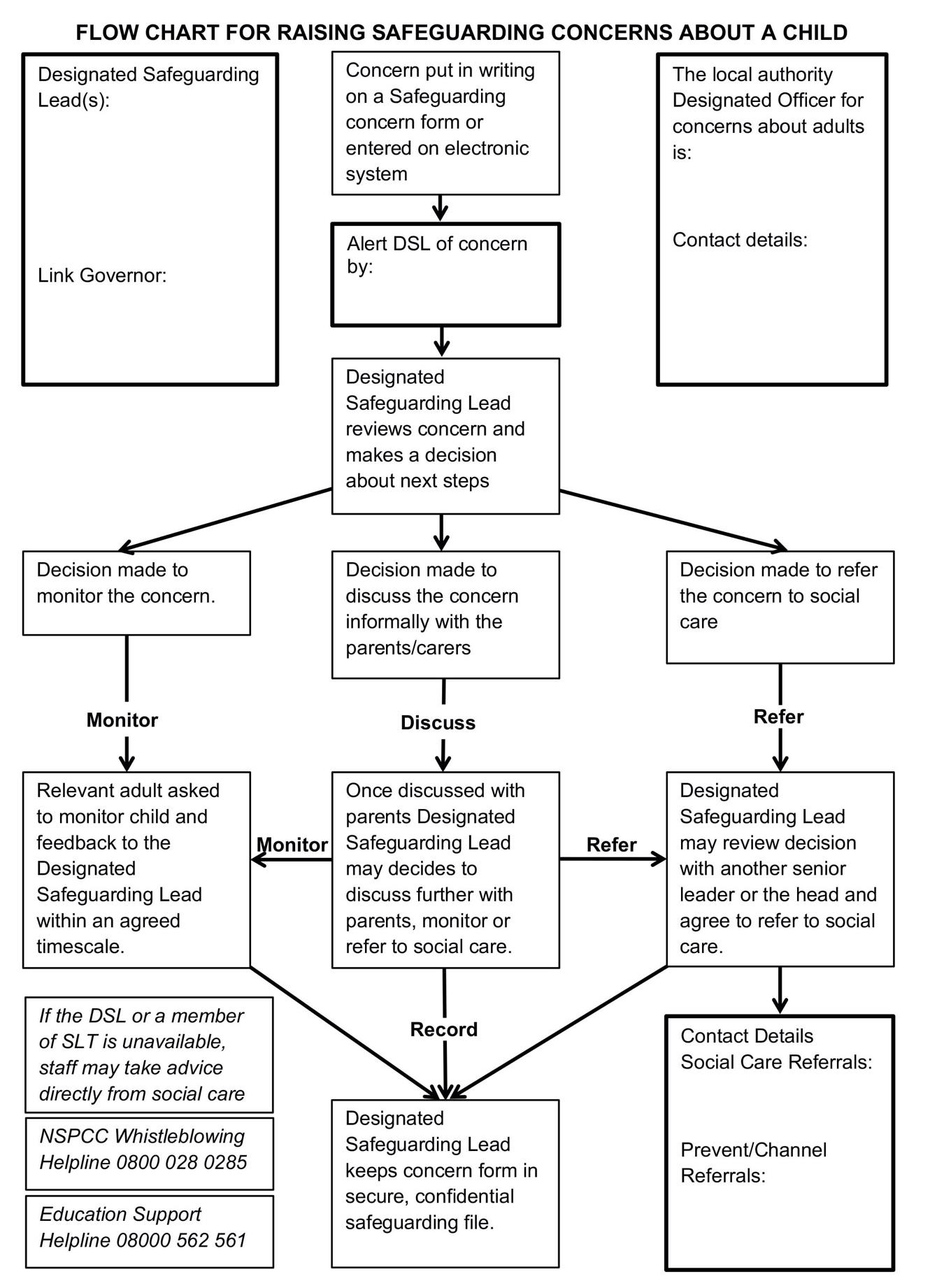
Woodlands Academy uses CPOMS for the monitoring of Safeguarding and Child Protection issues. Working alongside the Academy’s existing safeguarding processes, CPOMS will help with the management of child protection, behavioural issues, bullying, special educational needs, domestic issues and much more.
Every member of staff across the Academy has an obligation to report any concerns which they may have using CPOMS. The system allows the Academy to record information in a central repository and have relevant people alerted immediately.
All staff that have access are expected to report their concerns using CPOMS, staff will still have the opportunity to ask for advice from the Safeguarding Team.
CPOMS Instructions can be found in Appendix 6
Anyone who does not have access to CPOMS will be expected to fill in an Academy incident form. Academies to insert paragraph explaining this process.
For those members of staff that cannot access CPOMS, Supply staff, volunteers, external agencies each Academy will ensure that they are made aware of the Academies process required to report a Safeguarding incident using the following incident form.
Safeguarding Referral Form (to be used it a disclosure is made by a pupil or parent/carer
This form should be used when pupil or parent/carer disclosed to any member of staff or volunteer that they or another pupil is suffering from, or is at risk of, abuse (defined as ‘significant harm’. Please refer to the guidance overleaf before proceeding, and when completed, pass the form immediately to the Designated Safeguarding Lead or their Deputy.
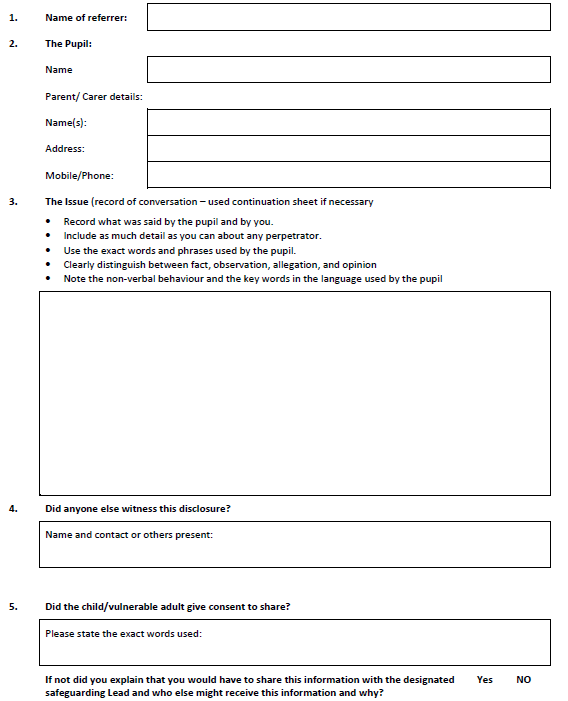
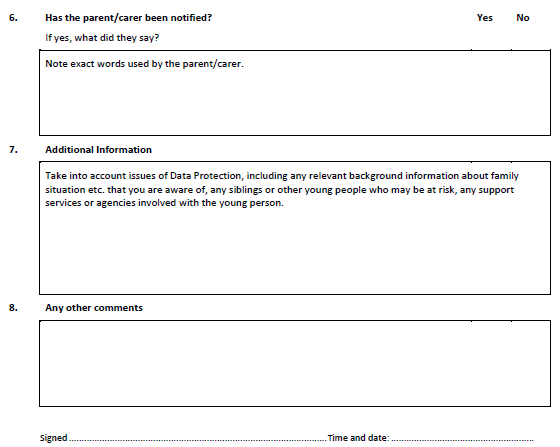
Ensure the pupil is safe and being cared for before you leave them and be clear what you have agreed about contacting them and their parent/carer.
This form and any notes taken must be passed to the Designated Safeguarding Lead or their Deputy as soon as possible and in any event no later than the end of the timetabled day. Keep a copy for yourself.
If the allegation or complaint is made against the Designated Safeguarding Lead or their Deputy, this information should be passed directly to Principal.

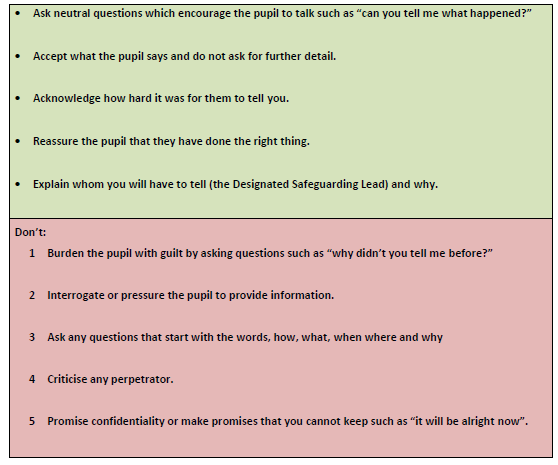
The TED Framework is useful:
TELL ME
EXPLAIN TO ME
DESCRIBE TO ME
All forms should be signed off by the Designated Safeguarding Lead and filed securely. The outcome must also be recorded.
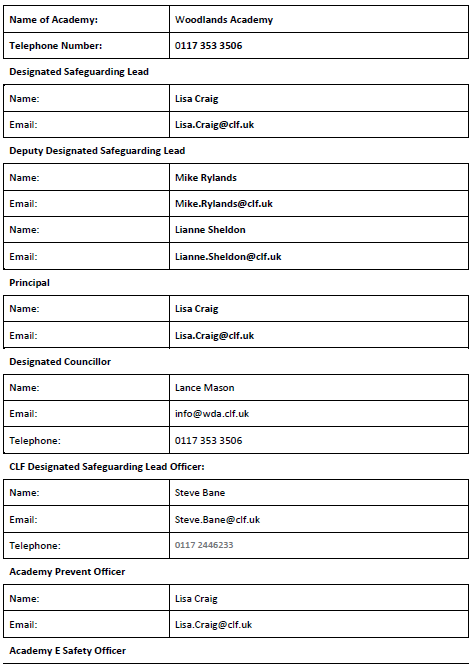

Bristol
Nicola Laird
0117 9037795
07795 091020
nicola.laird@bristol.gcsx.gov.uk
South Glos
Tina Wilson
01454 868508
Tina.wilson@southglos.gov.uk
North Somerset
Julie Bishop
01275 888624
Julie.bishop_hss@n_somerset.gov.uk
BANES
Jackie Deas
01225 396810
Jackie_deas@bathnes.gov.uk
Bristol (First Response)
0117 9036444
South Glos (access and response)
01454 866000
North Somerset (Single Point Access
01275 888808
BANES (Children’s Social Work Services)
01225 396339
Bristol
0117 9031414
South Glos
01454 866000
North Somerset
01275 888808
BANES
01225 396974
Emergency Duty Team for all Local Authority Areas within the Cabot Learning Federation 01454 615165
If there is an immediate risk of significant harm ring the Police on 999 The following telephone numbers may be useful for pupils:
Police Child Abuse Investigation Team:
0845 456 7000
Childline:
0800 1111
NSPCC:
0808 800 5000
If a member of staff is concerned that a pupil may be suffering harm, the matter should be referred to the Designated Safeguarding Lead as soon as possible. All suspicion or allegation of abuse must be reported to the Designated Safeguarding Lead or the Deputy Designated Safeguarding Lead, or if the complaint involves the Designated Safeguarding Lead, to the principal.
All staff should be aware of the early help process and understand their role in it. This includes identifying emerging problems, liaising with the designated safeguarding lead, sharing information with other professionals to support early identification and assessment and, in some cases, acting as the lead professional in undertaking an early help assessment.
All staff should be aware of the process for making referrals to children’s social care and for statutory assessments under the Children Act 1989 that may follow a referral, along with the role they might be expected to play in such assessments.
CLF Academies will work with social care, police, health services and other services to promote the welfare of children and protect them from harm. This includes providing a co- ordinated offer of early help when additional needs are identified and contributing to inter- agency plans to provide additional support to children subject to child protection plans.
The action will take into account:
A referral to Children’s Social Care or Police will not normally be made where:
General or national guidance will not be included here. A summary of specific duties are in Keeping Children Safe in Education 2024 Appendix B and Access to local guidance can be found in Appendix A of this document.
In recognition that the threshold of child protection is ‘likely to suffer’ significant harm, Woodlands Academy may need to make a referral to children’s social care. Where possible, this will involve notifying the parent/carer if it does not place the learner at further risk of harm. In all other circumstances information will be shared in line with section Information Sharing.
It is also important to recognise the importance of liaising with other education settings who may have siblings attending. It is likely that they may hold additional information which will support early identification of harm and in turn develop your assessment of need.
Woodlands Academy will ensure that early help intervention is provided as soon as a concern of exploitation is identified. Discussion and advice will be sought from targeted services to consider what support may be available. The learner and their families will be part of any planning and interventions.
Operation Encompass is a national operation where local police forces notify when the police are called to an incident to domestic abuse. Avon and Somerset have their own version of this and will notify education settings whenever they have responded to a domestic abuse incident. This will enable the education setting to take proactive action and reasonable adjustments in relation to behaviour management and achieving positive educational outcomes.
Under the current information sharing protocol, the education setting is not permitted in sharing this information without seeking consent from Avon and Somerset police in case this can put a victim and learners at further risk of harm. The only exception to this when information is shared with new education setting (part of statutory duties in relation to transfer of the Safeguarding/ Child Protection file, Keeping Children Safe in Education). Additional instructions around this are sent out with every single notification.
Mandatory reporting duty: Click here for government guidance
This is a legal duty for all professionals undertaking teaching work to report known cases of FGM to the police via 101. This is when they:
These cases must be referred to the DSL who will support them to carry out their duty. It is also advised any referrals made to the police under the mandatory reporting duty is followed up with children’s social care, so an assessment of need and support is concurrently considered.
Travel:
National guidance has highlighted going on holiday to a risk affected country is cause for concern, local guidance has been developed to prevent discriminatory action against families from risk affected communities.
Peer on Peer Abuse – linked to section within main body of this policy.
To be read in conjunction with the above section around Child Criminal Exploitation. There has been local guidance issued on the issue of ‘Offensive Weapons in Education Settings’.
It is important to note that should a weapon be used or there is threat of use, the police should be called immediately.
All schools and colleges are subject to a duty under section 26 of the Counterterrorism and Security Act 2015 (the CTSA 2015), in the exercise of their functions, to have “due regard109 to the need to prevent people from being drawn into terrorism”.110 This duty is known as the Prevent duty.
The Prevent duty should be seen as part of schools’ and colleges’ wider safeguarding obligations. Designated safeguarding leads and other senior leaders should familiarise themselves with the revised Prevent duty guidance: for England and Wales, especially paragraphs 57-76, which are specifically concerned with schools (and also covers childcare).
The guidance is set out in terms of four general themes:
A private fostering arrangement is one that is made privately (without the involvement of a local authority) for the care of a child:
Cases of private fostering arrangements must be reported to children’s social care to ensure that needs are adequately made.
Statutory guidance states that this should be done at least 6 weeks before the arrangement is due to start or as soon as you are made aware of the arrangements. Not to do so is a criminal offence.
Further support and reasonable adjustments should be made by the education setting to promote achievement of positive educational outcomes.
A learner missing from education is a potential indicator of abuse or neglect, or maybe an indicator of need for early help support. Staff should follow procedures for unauthorised absence and for dealing with children that go missing from education, particularly on repeat occasions. These should be reported to the DSL and reviewed in line with 2.3 Identifying and monitoring the needs of vulnerable learners.
Woodlands Academy will follow the guidance detailed in Children Missing Education (2016) and ( inset local authority guidance) Bristol City Council Education Welfare Service – Children Missing Education
This will include notifying the local authority in which the child lives:
A young carer is a person under 18 who regularly provides emotional and/or practical support and assistance for a family member who is disabled, physically or mentally unwell or who misuses substances.
The setting will support learners who are young carers to appropriate support. To find out what is available locally visit the (INSERT LOCAL AUTHORITY GUIDANCE) Bristol City Council Website – https://www.bristol.gov.uk/social-care-health/support-for-young-carers
The Carers Support Centre can undertake an assessment of need and provide bespoke support. https://www.carerssupportcentre.org.uk/young-carers/making-a-referral/
The Federation has procedures for dealing with allegations against staff (and volunteers, agency staff and supply teacher who work with children) that aim to strike a balance between the need to protect children and young people from abuse and the need to protect staff and volunteers from false or unfounded allegations. These procedures follow Part 4 of Keeping Children Safe in Education and Local Council Safeguarding Board arrangements.
Detailed guidance is given to staff to ensure that their behaviour and actions do not place pupils or themselves at risk of harm or allegations of harm to a pupil. This guidance is contained in the Staff Manual. Each Academy’s policy on physical restraint is included in the physical contact guidance.
The procedure below is followed when staff or volunteers have (or are alleged to have):
Any allegations not meeting this criterion will be dealt with in accordance with the [Bristol City Council] Safeguarding Children Board’s procedures. Advice from the LADO (Local Authority Designated Officer) will be sought in borderline cases.
The LADO will be informed immediately (and at the latest within 24 hours) and in any event within one working day of all allegations against staff and volunteers that come to the attention of the Academy and appear to meet these criteria. All such allegations must be dealt with as a priority so as to avoid any delay.
All staff, Councillors, and volunteers in the Academy (including those senior pupils in a position of responsibility) have a responsibility to familiarise themselves with this policy so that they can understand what to do if they receive an allegation against a member of staff or have concerns about the behaviour of a member of staff.
The Academy will make every reasonable effort to maintain confidentiality and guard against unwanted publicity whilst an allegation is being investigated or considered. Parents and carers should be made aware of the reporting restrictions preventing publication of any material relating to allegations about staff. The Academy will liaise with the Local Authority Designated Officer (LADO), police and Children’s Social Care as to managing confidentiality as appropriate.
This should be read in conjunction with the staff code of conduct and Keeping children Safe in Education (2024) and the CLF Low Level Concerns Policy. A low-level concern is not insignificant. This process should be used in events where a concern about professional conduct does not meet the threshold set out at the beginning of this section.
An allegation made against teachers and other staff (including volunteers, agency staff and supply teachers) must be reported immediately to the Principal of the Academy. Should the initial allegation first be made to any other member of staff, then that member of staff must either request the person raising the allegation to report it to the principal or if that is not possible to pass details of the allegation to the principal immediately (save where the matter concerns the principal in which case the Executive Principal should be notified). Where appropriate, the Principal or Executive Principal will consult with the Designated Safeguarding Lead and the allegation will be discussed immediately with the LADO before further action is taken.
Where an allegation or complaint is made against the Designated Safeguarding Lead or any other member of staff or a volunteer, the matter should be reported immediately to the principal.
Where an allegation or complaint is made against the principal, the person receiving the allegation should immediately inform the Executive Principal, without first notifying the principal.
If it is not possible to report to the principal in the circumstances set out above, a report should be made immediately to the Designated Safeguarding Lead or, if he / she is unavailable, the Deputy Designated Safeguarding Lead. The Designated Safeguarding Lead will take action in accordance with these procedures and will as soon as possible inform the principal or, where appropriate, the Executive Principal.
The person taking action in accordance with these procedures is known as the “case manager”.
The LADO will be informed of all allegations which appear to meet the above criteria before further action is taken.
The Principal/Executive Principal will discuss the matter with the LADO and where necessary, the LADO will obtain further details of the allegation and the circumstances in which the allegation was made. The Academy will act in accordance with any advice given by the LADO and will not investigate allegations or inform any individuals without the LADO’s consent.
The Academy may take action in the event of allegations against staff in accordance with its disciplinary procedures.
Disclosure of Information
The case manager will inform the accused person of the allegation as soon as possible after the LADO has been consulted.
The parents or carers of the child / children involved will be informed of the allegation as soon as possible if they do not already know of it. They will also be kept informed of the progress of the case, including the outcome of any disciplinary process.
Where the LADO advises that a strategy discussion is needed, or the Police or Children’s Services need to be involved, the case manager will not inform the accused or the parents or carers until these agencies have been consulted and it has been agreed what information can be disclosed.
The reporting restrictions preventing the identification of a teacher who is the subject of such an allegation in certain circumstances will be observed.
Action to be taken against the accused.
An Academy has a duty of care towards its employees and as such, it must ensure that effective support is provided for anyone facing an allegation. Individuals will be informed of concerns or allegations as soon as possible and given an explanation of the likely course of action, unless external agencies object to this. A representative will be appointed to keep him or her informed of the progress of the case and to consider what other support is available for the individual, as appropriate.
Where an investigation by the police or children’s services is unnecessary, the LADO will discuss the steps to be taken with the case manager. The appropriate action will depend on the nature and circumstances of the allegation and will range from taking no further action to dismissal or a decision not to use the person’s services in the future.
It may be necessary to undertake further enquiries to determine the appropriate action. If so, the LADO will discuss with the case manager how and by whom the investigation will be undertaken. The appropriate person will usually be a senior member of staff, but in some instances, it may be appropriate to appoint an independent investigator as advised by the Local Safeguarding Children Board.
Suspension will not be an automatic response to an allegation but will be considered where the circumstances warrant it, including:
Consideration will be given to whether the result that would be achieved by suspension could be obtained by alternative arrangements, for example, redeployment either within or outside of the Academy or providing an assistant when the individual has contact with children. The LADO will be contacted for advice if necessary.
If suspension is deemed appropriate, the reasons and justifications will be recorded by the Academy and the individual will be notified in writing of the reasons usually within one working day. Appropriate support will be provided for the suspended individual and contact details provided.
At the conclusion of a case where an allegation is substantiated, the LADO and the Academy should review the circumstances of the case to determine whether there are any improvements to be made to the Academy’s procedures and practices.
The Academy will consult with the LADO following the conclusion of a criminal investigation or prosecution as to whether any further action, including disciplinary action, is appropriate and if so, how to proceed. The options will depend on the circumstances of the case, including the result of the police investigation or trial and the standards of proof applicable.
If it is decided that the person who has been suspended should return to work, the Academy will consider how best to facilitate this, for example, arranging a phased return and / or the provision of a mentor to provide assistance and support in the short term. The Academy will also consider how to manage the contact with the child / children who made the allegation.
If the Federation ceases to use the services of a member of staff (or a Director, Councillor or Volunteer) because they are unsuitable to work with children, a settlement/compromise agreement will not be used and a referral to the Disclosure and Barring Service, PO Box 181, Darlington DL1 9FA, 01325 953795, dbsdispatch@dbs.gsi.gov.uk, will be made as soon as possible if the criteria are met. Any such incidents will be followed by a review of the safeguarding procedures within the Federation, with a report being presented to the Cabot Learning Federation Trust Board without delay.
If a member of staff or volunteer tenders his or her resignation, or ceases to provide his or her services, any child protection allegations will still be followed up by the Academy in accordance with this policy and a referral will be made to the Disclosure and Barring Service as soon as possible if the criteria are met.
Where a teacher has been dismissed or would have been dismissed had he / she not resigned, separate consideration will be given as to whether a referral to the National College for Teaching and Leadership should be made.
Early Years Foundation Stage – the Principal of the Academy will inform Ofsted as soon as reasonably practicable and at the very latest within 14 days of the allegation being made of any allegation of serious harm or abuse by any person living, working, or looking after children at the premises (whether that allegation relates to harm or abuse committed on the premises or elsewhere).
Details of allegations found to be malicious will be removed from personnel records.
For all other allegations, full details will be recorded on the confidential personnel file of the person accused. The record will be retained at least until the individual has reached normal retirement age or for a period of ten years from the date of the allegation if this is longer.
An allegation that is unsubstantiated, unfounded, or malicious will not be referred to in employer references.
The principal will consider whether to take disciplinary action in accordance with the Academy’s behaviour policy where an allegation by a pupil is shown to be malicious or deliberately invented (as well as whether a referral to the police is necessary if there are grounds for believing a criminal offence may have been committed).
The allegation will also be removed from the personnel records and will not be included in references.
Whether or not the person making the allegation is a pupil or a parent (or other member of the public), the Academy reserves the right to contact the police to determine whether any action might be appropriate.
It is in everyone’s interest for cases to be resolved as quickly as possible consistent with a fair and thorough investigation.
All allegations must be dealt with as a priority to avoid any delay. Where it is clear immediately that the allegation is unsubstantiated or malicious, the case should be resolved within one week. It is expected that most cases of allegations of abuse against staff will be resolved within one month with exceptional cases being completed within 12 months. If the nature of the allegation does not require formal disciplinary action, the principal should institute appropriate action within three working days. If a disciplinary hearing is required and can be held without further investigation, it should be held within 15 working days.
A pupil against whom an allegation of abuse has been made may be suspended from the Academy during the investigation and the Academy’s policy on behaviour, discipline and sanctions will apply.
The Academy will take advice from Children’s Social Care on the investigation of such allegations and will take all appropriate action to ensure the safety and welfare of all pupils involved including the pupil or pupils accused of abuse.
If it is necessary for a pupil to be interviewed by the police in relation to allegations of abuse, the Academy will ensure that, subject to the advice of children’s social care, parents/carers are informed as soon as possible, and that the pupil is supported during the interview by an appropriate adult.
In the case of pupils whose parents/carers are abroad, the pupil’s Education Guardian will be requested to provide support to the pupil and to accommodate him/her if it is necessary to suspend him/her during the investigation.
All staff are informed of the separate procedure to be used for searching for, and if necessary, reporting any pupil missing from school. The procedure includes the requirement to record any incident, the action taken, and the reasons given by the pupil for being missing. Please see the Academy’s Attendance Policy for further details.
A bullying incident will be treated as a Child Protection concern where there is reasonable cause to suspect that a child is suffering, or is likely to suffer, significant harm.
There may be occasions when a pupil’s behaviour warrants a response under Child Protection Procedures rather than the Academy’s disciplinary procedures. The Academy will take advice from children’s social care as to the appropriate action to take. Parents/carers will usually be informed as soon as possible, unless it is not in the best interests of the child to do so.
The Federation will take all practicable steps to ensure that Academy premises are as secure as circumstances permit. Local Academy procedures cover emergency events including lock down procedures.
Visitors will be required to show picture identification and evidence of DBS clearance, where appropriate. Visitors unable to provide evidence of DBS clearance and/or picture identification will be accompanied by a member of staff at all times while on the Academy site.
In EYFS settings, under no circumstances are images, videos, or audio recordings to be made without the prior consent of the Designated Safeguarding Lead or Principal. Where such recordings are to be taken, written permission must be obtained from parents/carers, who have the right to refuse. This consent may be obtained generally via a single permission form. Personal mobiles may not be used when children are present but may be used in designated areas during break times; under no circumstances are images, videos, or audio recordings to be made on personal mobiles.
A member of staff who suspects that a pupil is suffering harm from outside the Federation should seek information from the child with tact and sympathy using “open” and not leading questions. A sufficient record should be made of the conversation and if the member of staff continues to be concerned, he or she should refer the matter to the Designated Safeguarding Lead.
If we receive an allegation relating to an incident that happened when an individual or organisation was using (Woodlands Academy) premises for the purposes of running activities for children (for example community groups, sports associations, or service providers that run extra-curricular activities) it is required that the Academy Safeguarding Team report any incidents.
As with any safeguarding allegation we will follow our safeguarding procedures, including informing the LADO.
Parents/carers will normally be kept informed of any action to be taken under these procedures. However, there may be circumstances when the Designated Safeguarding Lead will need to consult the Principal, the LADO, children’s social care and/or the police before discussing details with parents/cares.
Any Child Protection incidents at the Academy will be followed by a review of the safeguarding procedures within the Academy and a prompt report to the Academy’s Council. Where an incident involves a member of staff, the LADO will assist in this review to determine whether any improvements can be made to the Academy’s procedures.
The Designated Safeguarding Lead will monitor the operation of this policy, its procedures and implementation and ensure they are updated and reviewed regularly, working with the Councillors as necessary. The Academy Councils will also make an annual report to The Federation Trust Board.
The Federation Trust Board will undertake an annual review of this policy and its procedures including good cooperation with local agencies and the efficiency with which their duties under it have been discharged.
The Federation Trust Board will ensure that any deficiencies or weaknesses regarding child protection arrangements are remedied without delay.
Section 26 of the Counterterrorism and Security Act 2015 places a duty on certain bodies (such as school and academies) to have “due regard to the need to prevent people from being drawn into terrorism”.
The Prevent Strategy, published by the Government in 2011, has three specific strategic objectives:
There is an increasing recognition that there is a need to safeguard children and young people and their families from violent extremism. We are aware of local situations where extremist groups have attempted to radicalise vulnerable young people in our community, or to steer them into a rigid and narrow ideology that is intolerant of diversity and leaves them vulnerable to radicalisation.
Extremism is the vocal or active opposition to our fundamental values, including democracy, the rule of law, individual liberty and the mutual respect and tolerance of different faiths and beliefs. This also includes calling for the death of members of the armed forces.
Radicalisation refers to the process by which a person comes to support terrorism and extremist ideologies associated with terrorist groups.
Terrorism is an action that endangers or causes serious violence to a person/people; causes serious damage to property; or seriously interferes or disrupts an electronic system. The use or threat must be designed to influence the government or to intimidate the public and is made for the purpose of advancing a political, religious, or ideological cause.
The national guidance requires academies to take a ‘risk-based approach’ to the Prevent Strategy, in order to gain an awareness and understanding of the risk of radicalisation in the local area as well as in their institution, and to understand that no setting is risk-free.
Academies are required to focus on the risks of violent extremism, which represent the greatest threat at national level, while recognising that other forms of violence and extremism can, and do, manifest themselves. The revised Ofsted guidance (Sept 2014) states:
‘Inspectors should take into account whether learners are suitably protected from the risks associated with radicalisation and extremism’ and most importantly, that ‘learners feel safe’.
An annual risk assessment will be carried out by the Designated Safeguarding Lead of each Academy in the format required by their Local Authority and Local Safeguarding Children Board.
Preventing violent extremism will be seen as part of the safeguarding duties of all Academies in the Federation, and this Policy will be monitored as part of the Federation’s overall Safeguarding Policy.
In general, Academies have a statutory responsibility to:
The Academies Prevent Officer Lisa Craig will act as the lead for the Prevent agenda.
The Prevent Officer will ensure that:
In relation to pupils identified as at risk of radicalisation, the Designated Safeguarding Lead will:
*Channel is a multi-agency approach to provide support to individuals who are at risk of being drawn into terrorist related activity.
Preventing violent extremism work will not be directed at any specific ideology, religion, religious group, or religious faith, or at the proponents of any other sets of beliefs. Its principal aim is to ensure that Academies are able to monitor, manage and deal effectively with the threat posed by any individual or group of individuals engaging in violent extremism in the name of ideology or belief.
Academies will make clear that there is no such thing as a “typical extremist”: those who become involved in extremist actions come from a range of backgrounds and experiences, and most individuals who hold radical views do not become involved in extremist activity.
Academies can play a significant role in preventing radicalisation by fostering shared values and promoting community cohesion, which in turn, can prevent pupils from in getting involved in violent extremism.
The Federation values freedom of speech as a fundamental right in our society, however, recognises that free speech must be subject to the laws on equality and human rights, and to the policies of the Federation.
Academies also have Equality Act duties which they will actively implement and report on. These are to:
The Federation recognises that effective engagement with parents/carers/families and the local community (including faith communities and supplementary schools) is also important, as they are in a key position to spot signs of radicalisation. It is important to assist and advise families who raise concerns and be able to point them to the right support mechanisms.
All Academies will review their existing policies to ensure they address Prevent issues (e.g., Health and Safety, E-Safety, Premises, Bullying and Harassment).
Pupils may become susceptible to radicalisation through a range of social, personal, and environmental factors. It is known that violent extremists target vulnerable individuals to drive a wedge between them and their families and communities. It is vital that Academy staff are able to recognise and support those who may be vulnerable. The Cabot Learning Federation are determined to protect young people from extremism and terrorism. This includes all forms of extremism across the spectrum: violent and nonviolent, from Islamist Extremism to the Extreme Far Right.
Indicators may include:
However, this list is not exhaustive, nor does it mean that all young people experiencing the above are at risk of radicalisation for the purposes of violent extremism.
More critical risk factors could include:
In 2014, guidance was produced for maintained schools about incorporating ‘British values’ as part of their duty to promote SMSC (spiritual, moral, social, and cultural curriculum) under Section 78 of the 2002 Education Act. These are defined as ‘the fundamental British values of democracy, the rule of law, individual liberty, and mutual respect and tolerance of those with different faiths and beliefs.’ The guidance advises that attempts to promote systems that undermine fundamental ‘British values’ would be completely at odds with the duty to provide SMSC.
Promoting these values can be done through the taught curriculum, through collective worship, the Academy ethos and through positive role modelling.
Through their provision of SMSC, academies are expected to:
Academies will be expected to map British Values annually against the whole curriculum and to agree in which areas learning on these issues can be strengthened (See Appendix 5).
Woodlands Academy is dedicated to ensuring that learners are taught about safeguarding, including online safety. We recognise that a one size fits all approach may not be appropriate for all learners, and a more personalised or contextualised approach for more vulnerable learners, victims of abuse and some SEND children might be needed. This is part of a broad and balanced curriculum.
This includes:
To ensure that pupils are protected, it is important to have in place good pastoral and support systems that support the most vulnerable. This should include:
Academies will consult with their pupils, staff, and parents/carers about their requirements in relation to their faith or religious practice.
Academies will try to meet any identified needs, where practicable, for example, providing dedicated multi-faith prayer space or meeting particular religious dietary needs.
Academies will review their site security measures and their procedures for dealing with visitors and with external speakers to ensure that no-one is able to enter the site and influence the pupils and encourage them into radicalisation.
All Academies will have in place procedures for dealing with a major incident of terrorism or violent extremism e.g., lock down, and will carry out regular practices.
Academies will regularly review their policies relating to the use of IT to ensure that they are up to date in terms of the threats that new social media etc. present and contain specific reference to the Prevent Duty. They will specifically look at the use of filtering as a means of restricting access to harmful content. If appropriate, they will develop clear policies for students and staff using IT equipment to research terrorism and counter terrorism during their learning. Guidance can be found in the CLF E-Safety policy.
E-safety will also be included in the curriculum for all pupils, whatever their age, and issues of radicalisation will be discussed as appropriate.
The Government guidance requires key ‘British Values’ are taught in all schools and academies. They define these in the 2011 Prevent Strategy as:
Cabot Learning Federation has clear policies on Equality and Diversity and is committed to promoting community cohesion and fostering good relations between all of the staff, pupils and their families who form part of our community.
We recognise and will celebrate the multi-cultural, multi- faith and ever-changing of the area in which our academies are based.
We understand the vital role the Federation can play in ensuring that groups or individuals within the Academies are not subjected to discrimination, bullying, harassment, or intimidation and will actively promote our policies and procedures to address these issues.
We will work through our safeguarding policies and practices to prevent the radicalisation of our pupils by those wishing to unduly, or illegally, influence them.
We will actively implement our duties under the Equality Act 2010 to prevent discrimination against any individual or group, on grounds of religion or belief, race or ethnicity, gender reassignment, sex, disability, and the other characteristics named in the Act.
The Federation is dedicated to preparing pupils for their adult life through the formal and informal curriculum, ensuring that it models, promotes and reinforces ‘British values’ to all its students.
Each Academy will use strategies within the National Curriculum and beyond, to secure such outcomes for pupils. Each year they will map how British Values are delivered in their institution, and any areas they intend to address.
The examples that follow show currently some of the many ways Woodlands Academy seeks to embed ‘British values.
Type this address https://woodlandsbristol.cpoms.net/auth/identity?origin=https%3A%2F%2Fwoodlandsbristol.cpoms.net%2Fdash into your search bar. You will arrive at this screen.

If you have clicked on “Forgotten your password” or you are using CPOMS for the first time you will arrive at this screen.

Type in your work email address (i.e., jbloggs@clf.uk) and click on Reset Password. An email will be sent to you with your new password.
Return to the original screen.
Enter your email address and password and click on Login.
Your Dashboard will open.
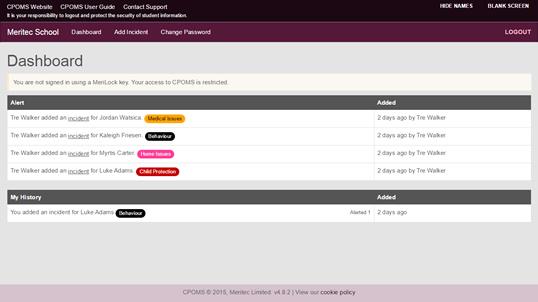
Restricted Access Dashboard
With restricted access you will only be able to add incidents and view those that you have been alerted to, and therefore you do not require key access. When you are logged in without a key, you will be notified that: ‘You are not signed in using a Meri Lock key. Your access to CPOMS is restricted.’
Once logged into the dashboard you will see your list of alerts. They again will tell you which member of staff has alerted you, which student the alert is for which category the incident falls under and finally when the incident alert was created. If you click on the word incident, you will be taken directly to view the incident. Once you have read the incident, you can mark as read to acknowledge that you have seen the incident and understand the content.
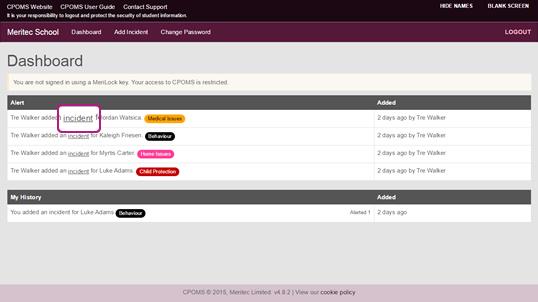
However, as you do not have key access, once you have marked as read, the alert will disappear from your alert’s dashboard, and you will not be able to read it again therefore if you are required to add any actions make sure to do this before you select the ‘mark as read’.
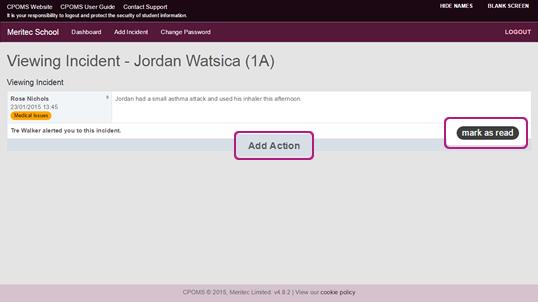
To add an incident to the system, click on the Add Incident Link at the top of the screen.
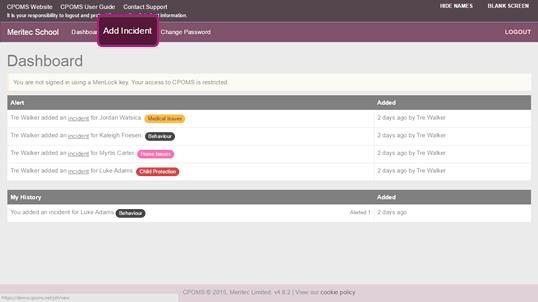
This will take you to the incident page where you can proceed to fill in all the required information.
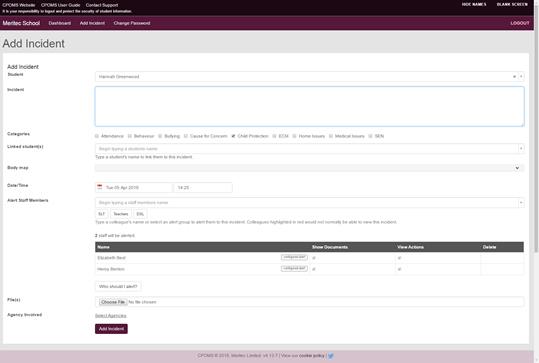
Please add a copy of your Local Authority referral process. The one below is from the Bristol Safeguarding Children’s Board.
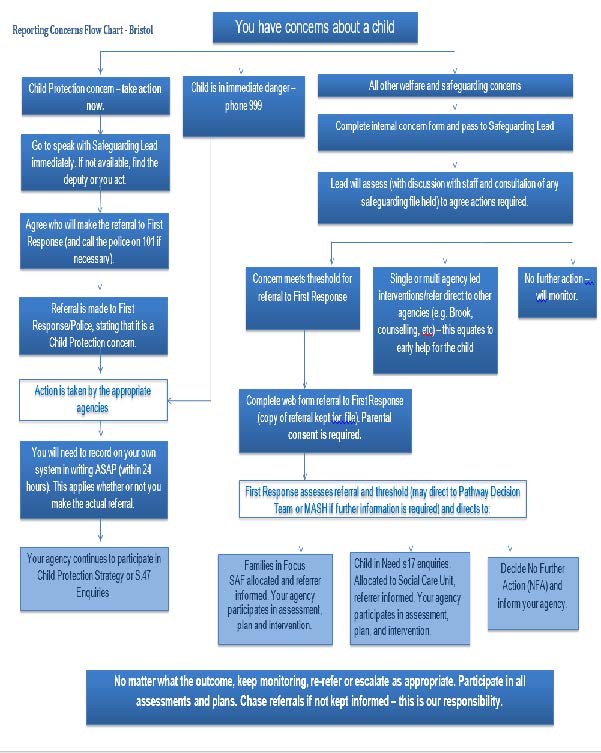
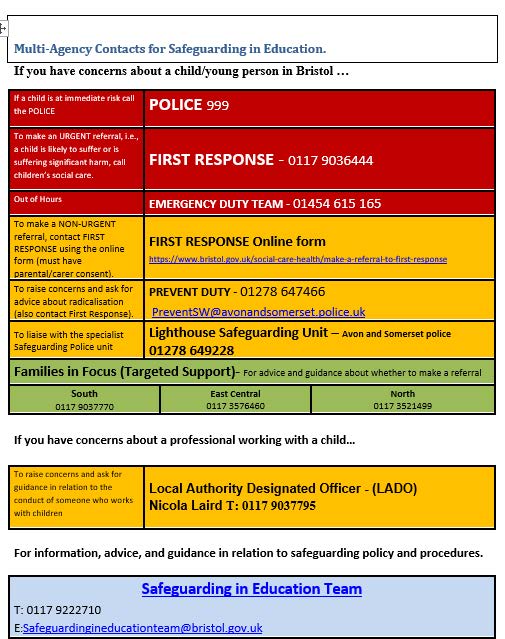
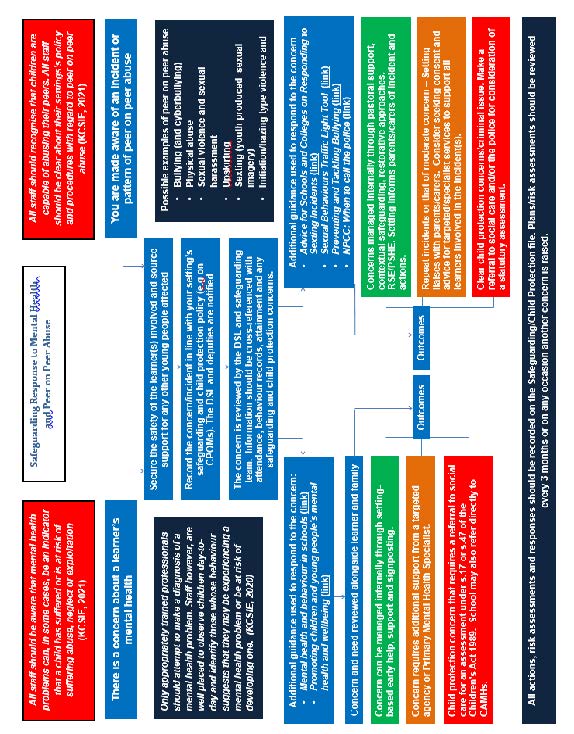
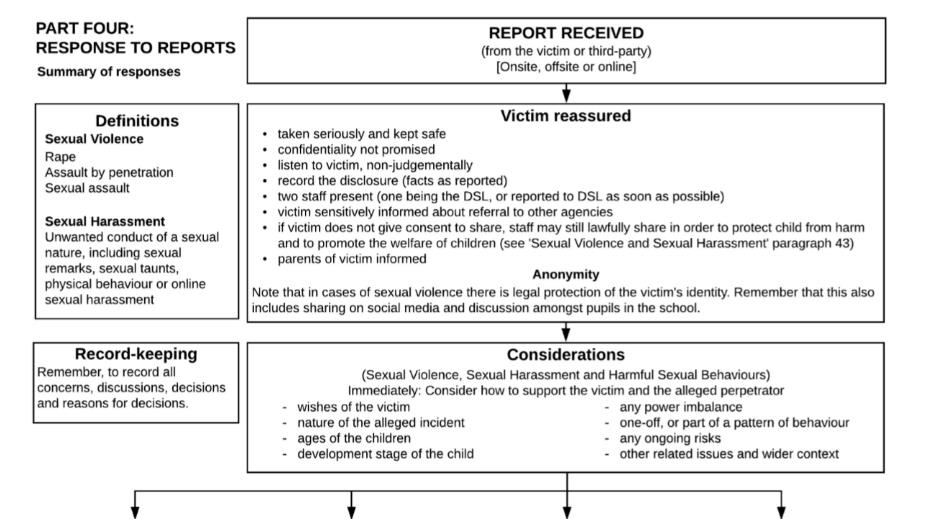
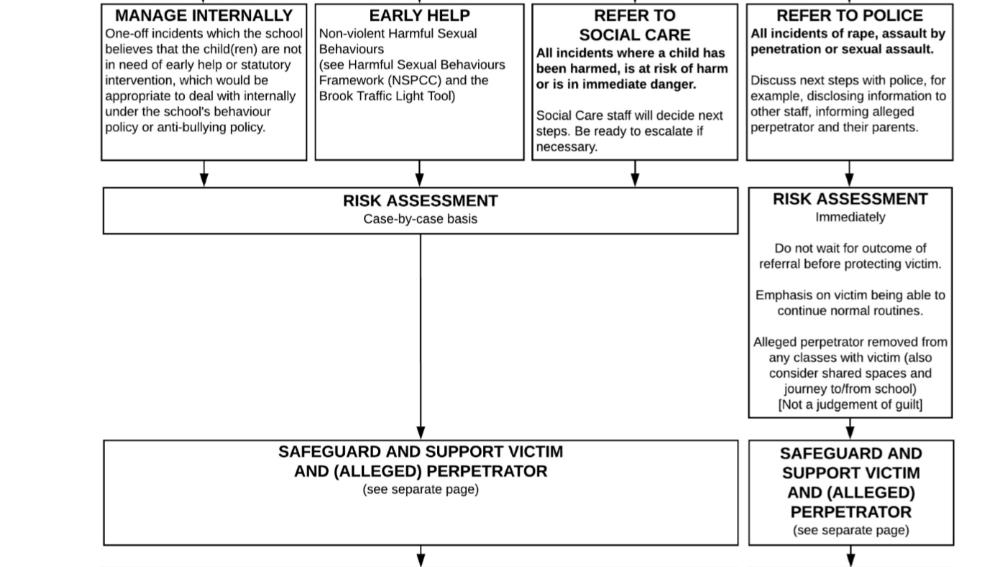

All staff should have an awareness of safeguarding issues that can put children at risk of harm.
We know that different forms of harm often overlap, and that perpetrators may subject children and young people to multiple forms of abuse, such as criminal exploitation (including county lines) and sexual exploitation.
In some cases, the exploitation or abuse will be in exchange for something the victim needs or wants (for example, money, gifts, or affection), and/or will be to the financial benefit or other advantage, such as increased status, of the perpetrator or facilitator.
Children can be exploited by adult males or females, as individuals or in groups. They may also be exploited by other children, who themselves may be experiencing exploitation – where this is the case, it is important that the child perpetrator is also recognised as a victim.
Whilst the age of the child may be a contributing factor for an imbalance of power, there are a range of other factors that could make a child more vulnerable to exploitation, including, sexual identity, cognitive ability, learning difficulties, communication ability, physical strength, status, and access to economic or other resources. Some of the following can be indicators of both child criminal and sexual exploitation where children:
Further information on signs of a child’s involvement in sexual exploitation is available in-home Office guidance: Child sexual exploitation: guide for practitioners.
County lines is a term used to describe gangs and organised criminal networks involved in exporting illegal drugs using dedicated mobile phone lines or other form of “deal line”. This activity can happen locally as well as across the UK – no specified distance of travel is required. Children and vulnerable adults are exploited to move, store, and sell drugs and money. Offenders will often use coercion, intimidation, violence (including sexual violence) and weapons to ensure compliance of victims.
Children can be targeted and recruited into county lines in several locations including schools (mainstream and special), further and higher educational institutions, pupil referral units, children’s homes, and care homes.
Children are also increasingly being targeted and recruited online using social media. Children can easily become trapped by this type of exploitation as county lines gangs can manufacture drug debts which need to be worked off or threaten serious violence and kidnap towards victims (and their families) if they attempt to leave the county lines network.
Several the indicators for CSE and CCE as detailed above may be applicable to where children are involved in county lines. Some additional specific indicators that may be present where a child is criminally exploited through involvement in county lines are children who:
Further information on the signs of a child’s involvement in county lines is available in guidance published by the Home Office.
Child abduction is the unauthorised removal or retention of a minor from a parent or anyone with legal responsibility for the child. Child abduction can be committed by parents or other family members; by people known but not related to the victim (such as neighbours, friends, and acquaintances); and by strangers.
Other community safety incidents in the vicinity of a school can raise concerns amongst children and parents, for example, people loitering nearby or unknown adults engaging children in conversation.
As children get older and are granted more independence (for example, as they start walking to school on their own) it is important they are given practical advice on how to keep themselves safe. Many schools provide outdoor-safety lessons run by teachers or by local police staff.
It is important that lessons focus on building children’s confidence and abilities rather than simply warning them about all strangers. Further information is available at: www.actionagainstabduction.org and www.clevernevergoes.org.
Approximately 200,000 children in England and Wales have a parent sent to prison each year. These children are at risk of poor outcomes including poverty, stigma, isolation, and poor mental health.
The National Information Centre on Children of Offenders, NICCO provides information designed to support professionals working with offenders and their children, to help mitigate negative consequences for those children.
All staff should be aware of the indicators, which may signal that children are at risk from, or are involved in serious crime.
The indictors can include:
Children can abuse other children. This is generally referred to as Child-on-Child abuse and can take many forms. This can include (but is not limited to) bullying (including cyberbullying); sexual violence and sexual harassment; physical abuse such as hitting, kicking, shaking, biting, hair pulling, or otherwise causing physical harm; sexting and initiating/hazing type violence and rituals.
Context Sexual violence and sexual harassment can occur between two children of any age and sex. It can also occur through a group of children sexually assaulting or sexually harassing a single child or group of children. Children who are victims of sexual violence and sexual harassment will likely find the experience stressful and distressing. This will, in all likelihood, adversely affect their educational attainment. Sexual violence and sexual harassment exist on a continuum and may overlap, they can occur online and offline (both physical and verbal) and are never acceptable. It is important that all victims are taken seriously and offered appropriate support. Staff should be aware that some groups are potentially more at risk. Evidence shows girls, children with SEND and Lesbian, Gay, Bisexual and Transgender children are at greater risk. Staff should be aware of the importance of:
Sexual violence it is important that school and college staff are aware of sexual violence and the fact children can, and sometimes do, abuse their peers in this way. When referring to sexual violence we are referring to sexual offences under the Sexual Offences Act 200319 as described below:
A person (A) commits an offence of rape if: he intentionally penetrates the vagina, anus, or mouth of another person (B) with his penis, B does not consent to the penetration and A does not reasonably believe that B consents.
A person (A) commits an offence if: s/he intentionally penetrates the vagina or anus of another person (B) with a part of her/his body or anything else, the penetration is sexual, B does not consent to the penetration and A does not reasonably believe that B consents.
A person (A) commits an offence of sexual assault if: s/he intentionally touches another person (B), the touching is sexual, B does not consent to the touching and A does not reasonably believe that B consents.
Consent is about having the freedom and capacity to choose. Consent to sexual activity may be given to one sort of sexual activity but not another, e.g.to vaginal but not anal sex or penetration with conditions, such as wearing a condom. Consent can be withdrawn at any time during sexual activity and each time activity occurs. Someone consents to vaginal, anal, or oral penetration only if s/he agrees by choice to that penetration and has the freedom and capacity to make that choice.
When referring to sexual harassment we mean ‘unwanted conduct of a sexual nature’ that can occur online and offline and both inside and outside of school/college. When we reference sexual harassment, we do so in the context of child-on-child sexual harassment. Sexual harassment is likely to: violate a child’s dignity, and/or make them feel intimidated, degraded, or humiliated and/or create a hostile, offensive or sexualised environment.
Whilst not intended to be an exhaustive list, sexual harassment can include:
As set out in UKCIS Sharing nudes and semi-nudes: advice for education settings working with children and young people (which provides detailed advice for schools and colleges) taking and sharing nude photographs of U18s is a criminal offence.
sharing of unwanted explicit content. upskirting (is a criminal offence30). sexualised online bullying.
unwanted sexual comments and messages, including, on social media; o sexual exploitation; coercion and threats.
The response to a report of sexual violence or sexual harassment. The initial response to a report from a child is incredibly important. How the school or college responds to a report can encourage or undermine the confidence of future victims of sexual violence and sexual harassment to report or come forward. Schools and colleges not recognising, acknowledging, or understanding the scale of harassment and abuse and/or downplaying of some behaviours can actually lead to a culture of unacceptable behaviour.
It is essential that all victims are reassured that they are being taken seriously and that they will be supported and kept safe. A victim should never be given the impression that they are creating a problem by reporting sexual violence or sexual harassment. Nor should a victim ever be made to feel ashamed for making a report. If staff have a concern about a child or a child makes a report to them, they should follow the referral process as set out from paragraph 55 in Part one Keeping Children Safe in Education. As is always the case, if staff are in any doubt as to what to do, they should speak to the designated safeguarding lead (or a deputy).
The Voyeurism (Offences) Act, which is commonly known as the Upskirting Act, came into force on 12 April 2019. ‘Upskirting’ is where someone takes a picture under a person’s clothing (not necessarily a skirt) without their permission and or knowledge, with the intention of viewing their genitals or buttocks (with or without underwear) to obtain sexual gratification, or cause the victim humiliation, distress, or alarm. It is a criminal offence. Anyone of any gender, can be a victim.
Approximately 200,000 children have a parent sent to prison each year. These children are at risk of poor outcomes including poverty, stigma, isolation, and poor mental health. NICCO https://www.nicco.org.uk/ provides information designed to support professionals working with offenders and their children, to help mitigate negative consequences for those children.
So-called ‘honour-based’ abuse (HBA) encompasses incidents or crimes which have been committed to protect or defend the honour of the family and/or the community, including female genital mutilation (FGM), forced marriage, and practices such as breast ironing. Abuse committed in the context of preserving “honour” often involves a wider network of family or community pressure and can include multiple perpetrators. It is important to be aware of this dynamic and additional risk factors when deciding what form of safeguarding action to take. All forms of HBA are abuse (regardless of the motivation) and should be handled and escalated as such. Professionals in all agencies, and individuals and groups in relevant communities, need to be alert to the possibility of a child being at risk of HBA, or already having suffered HBA.
If staff have a concern regarding a child that might be at risk of HBA or who has suffered from HBA, they should speak to the designated safeguarding lead (or deputy). As appropriate, they will activate local safeguarding procedures, using existing national and local protocols for multi-agency liaison with police and children’s social care. Where FGM has taken place, since 31 October 2015 there has been a mandatory reporting duty placed on teachers104 that requires a different approach (see following section).
FGM comprises all procedures involving partial or total removal of the external female genitalia or other injury to the female genital organs. It is illegal in the UK and a form of child abuse with long- lasting harmful consequences.
Section 5B of the Female Genital Mutilation Act 2003 (as inserted by section 74 of the Serious Crime Act 2015) places a statutory duty upon teachers along with regulated health and social care professionals in England and Wales, to report to the police where they discover (either through disclosure by the victim or visual evidence) that FGM appears to have been carried out on a girl under 18. Those failing to report such cases may face disciplinary sanctions. It will be rare for teachers to see visual evidence, and they should not be examining pupils or students, but the same definition of what is meant by “to discover that an act of FGM appears to have been carried out” is used for all professionals to whom this mandatory reporting duty applies. Information on when and how to make a report can be found at: https://www.gov.uk/government/publications/mandatory- reporting-of-female-genital-mutilation-procedural-information
Teachers must personally report to the police cases where they discover that an act of FGM appears to have been carried out. Unless the teacher has good reason not to, they should still consider and discuss any such case with the school’s or college’s designated safeguarding lead (or deputy) and
involve children’s social care as appropriate. The duty does not apply in relation to at risk or suspected cases (i.e., where the teacher does not discover that an act of FGM appears to have been carried out, either through disclosure by the victim or visual evidence) or in cases where the woman is 18 or over. In these cases, teachers should follow local safeguarding procedures. The following is a useful summary of the FGM mandatory reporting duty: FGM Fact Sheet.
https://assets.publishing.service.gov.uk/government/uploads/system/uploads/attachment_data/file/496415/6_1639_HO_SP_FGM_mandatory_reporting_Fact_sheet_Web.pdf
Forcing a person into a marriage is a crime in England and Wales. A forced marriage is one entered into without the full and free consent of one or both parties and where violence, threats or any other form of coercion is used to cause a person to enter into a marriage. Threats can be physical or emotional and psychological. A lack of full and free consent can be where a person does not consent or where they cannot consent (if they have learning disabilities, for example). Nevertheless, some perpetrators use perceived cultural practices as a way to coerce a person into marriage. Schools and colleges can play an important role in safeguarding children from forced marriage.
The Forced Marriage Unit has published statutory guidance https://www.gov.uk/guidance/forced- marriage and Multi-agency guidelines, https://assets.publishing.service.gov.uk/government/uploads/system/uploads/attachment_data/file/322307/HMG_MULTI_AGENCY_PRACTICE_GUIDELINES_v1_180614_FINAL.pdf pages 35-36 of
which focus on the role of schools and colleges. School and college staff can contact the Forced Marriage Unit if they need advice or information: Contact: 020 7008 0151 or email fmu@fco.gov.uk.
In addition, since February 2023 it has also been a crime to carry out any conduct whose purpose is to cause a child to marry before their eighteenth birthday, even if violence, threats, or another form of coercion are not used. As with the existing forced marriage law, this applies to non-binding, unofficial ‘marriages’ as well as legal marriages.
Children are vulnerable to extremist ideology and radicalisation. Similar to protecting children from other forms of harms and abuse, protecting children from this risk should be a part of a schools’ or colleges’ safeguarding approach.
There is no single way of identifying whether a child is likely to be susceptible to an extremist ideology. Background factors combined with specific influences such as family and friends may contribute to a child’s vulnerability. Similarly, radicalisation can occur through many different methods (such as social media or the internet) and settings (such as within the home). However, it is possible to protect vulnerable people from extremist ideology and intervene to prevent those at risk of radicalisation being radicalised. As with other safeguarding risks, staff should be alert to changes in children’s behaviour, which could indicate that they may be in need of help or protection. Staff should use their judgement in identifying children who might be at risk of radicalisation and act proportionately which may include the designated safeguarding lead (or deputy) making a Prevent referral.
The Prevent duty All schools and colleges are subject to a duty under section 26 of the CounterTerrorism and Security Act 2015 (the CTSA 2015), in the exercise of their functions, to have “due regard109 to the need to prevent people from being drawn into terrorism”. This duty is known as the Prevent duty. The Prevent duty should be seen as part of schools’ and colleges’ wider safeguarding obligations. Designated safeguarding leads and other senior leaders should familiarise themselves with the revised Prevent duty guidance: for England and Wales, especially paragraphs 57-76, which are specifically concerned with schools (and also covers childcare). The guidance is set out in terms of four general themes: risk assessment, working in partnership, staff training, and IT policies. There is additional guidance: Prevent duty guidance: for further education institutions in England and Wales that applies to colleges.
Channel is a voluntary, confidential support programme which focuses on providing support at an early stage to people who are identified as being vulnerable to being drawn into terrorism. Prevent referrals may be passed to a multi-agency Channel panel, which will discuss the individual referred to determine whether they are vulnerable to being drawn into terrorism and consider the appropriate support required. A representative from the school or college may be asked to attend the Channel panel to help with this assessment. An individual’s engagement with the programme is entirely voluntary at all stages. Guidance on Channel can be found at https://www.gov.uk/government/publications/channel-guidance
The Government has published further advice for schools on the Prevent duty. https://www.gov.uk/government/publications/protecting-children-from-radicalisation-the-prevent- duty
The advice is intended to complement the Prevent guidance and signposts to other sources of advice and support.
The Home Office has developed three e-learning modules:
Against Hate, is a government website designed to support school teachers and leaders to help them safeguard their students from radicalisation and extremism. The platform provides free information and resources to help school staff identify and address the risks, as well as build resilience to radicalisation.
https://educateagainsthate.com
For advice specific to further education, the Education and Training Foundation (ETF) hosts the Prevent for FE and Training. https://preventforfeandtraining.org.uk/ This hosts a range of free, sector specific resources to support further education settings comply with the Prevent duty. This includes the Prevent Awareness e-learning, which offers an introduction to the duty, and the Prevent Referral e-learning, which is designed to support staff to make robust, informed, and proportionate referrals.
Modern slavery encompasses human trafficking and slavery, servitude and forced or compulsory labour. Exploitation can take many forms, including sexual exploitation, forced labour, slavery, servitude, forced criminality and the removal of organs.
Further information on the signs that someone may be a victim of modern slavery, the support available to victims and how to refer them to the NRM is available in the Modern Slavery Statutory Guidance. Modern slavery: how to identify and support victims – GOV.UK (www.gov.uk)
The Domestic Abuse Act 2021 received Royal Assent on 29 April 2021. The Act introduces the first ever statutory definition of domestic abuse and recognises the impact of domestic abuse on children, as victims in their own right, if they see, hear or experience the effects of abuse. The statutory definition of domestic abuse, based on the previous cross-government definition, ensures that different types of relationships are captured, including ex-partners and family members. The definition captures a range of different abusive behaviours, including physical, emotional, and economic abuse and coercive and controlling behaviour. Both the person who is carrying out the behaviour and the person to whom the behaviour is directed towards must be aged 16 or over and they must be “personally connected” (as defined in section 2 of the 2021 Act).
Types of domestic abuse include intimate partner violence, abuse by family members, teenage relationship abuse and child/adolescent to parent violence and abuse. Anyone can be a victim of domestic abuse, regardless of sexual identity, age, ethnicity, socioeconomic status, sexuality or background and domestic abuse can take place inside or outside of the home. The government will issue statutory guidance to provide further information for those working with domestic abuse victims and perpetrators, including the impact on children.
All children can witness and be adversely affected by domestic abuse in the context of their home life where domestic abuse occurs between family members. Experiencing domestic abuse and/or violence can have a serious, long lasting emotional and psychological impact on children. In some cases, a child may blame themselves for the abuse or may have had to leave the family home as a result.
Young people can also experience domestic abuse within their own intimate relationships. This form of child-on-child abuse is sometimes referred to as ‘teenage relationship abuse’. Depending on the age of the young people, this may not be recognised in law under the statutory definition of ‘domestic abuse’ (if one or both parties are under 16). However, as with any child under 18, where there are concerns about safety or welfare, child safeguarding procedures should be followed and both young victims and young perpetrators should be offered support.
Operation Encompass operates in all police forces across England. It helps police and schools work together to provide emotional and practical help to children. The system ensures that when the police are called to an incident of domestic abuse, where there are children in the household who
have experienced the domestic incident, the police will inform the key adult (usually the designated safeguarding lead (or deputy)) in school before the child or children arrive at school the following day. This ensures that the school has up to date relevant information about the child’s circumstances and can enable immediate support to be put in place, according to the child’s needs. Operation Encompass does not replace statutory safeguarding procedures. Where appropriate, the police and/or schools should make a referral to local authority children’s social care if they are concerned about a child’s welfare. More information about the scheme and how schools can become involved is available on the Operation Encompass website. Operation Encompass provides an advice and helpline service for all staff members from educational settings who may be concerned about children who have experienced domestic abuse. The helpline is available 8AM to 1PM, Monday to Friday on 0204 513 9990 (charged at local rate).
National Domestic Abuse Helpline Refuge runs the National Domestic Abuse Helpline, which can be called free of charge and in confidence, 24 hours a day on 0808 2000 247. Its website provides guidance and support for potential victims, as well as those who are worried about friends and loved ones. It also has a form through which a safe time from the team for a call can be booked. Additional advice on identifying children who are affected by domestic abuse and how they can be helped is available at:
Cybercrime is criminal activity committed using computers and/or the internet. It is broadly categorised as either ‘cyber-enabled’ (crimes that can happen off-line but are enabled at scale and at speed on-line) or ‘cyber dependent’ (crimes that can be committed only by using a computer).
Cyber-dependent crimes include.
Children with particular skill and interest in computing and technology may inadvertently or deliberately stray into cyber-dependent crime. If there are concerns about a child in this area, the designated safeguarding lead (or a deputy), should consider referring into the Cyber Choices programme. This is a nationwide police programme supported by the Home Office and led by the National Crime Agency, working with regional and local policing. It aims to intervene where young people are at risk of committing, or being drawn into, low level cyber-dependent offences and divert them to a more positive use of their skills and interests. Note that Cyber Choices does not currently cover ‘cyber-enabled’ crime such as fraud, purchasing of illegal drugs on-line and child sexual abuse and exploitation, nor other areas of concern such as on-line bullying or general on-line safety.
Additional advice can be found at: Cyber Choices, ‘NPCC- When to call the Police’ and National Cyber
Security Centre – NCSC.GOV.UK
The breadth of issues classified within online safety is considerable and can be linked to issues such as child sexual exploitation and radicalisation. Issues can be categorised into three areas of risk:
The school will ensure it is proactive in addressing online safety through:
Staff need to demonstrate a knowledge and understanding of Hate crimes which are any crimes that are targeted at a person because of hostility or prejudice towards that person’s:
This can be committed against a person or property. The victim does not have to be a member of the group at which the hostility is targeted. In fact, anyone could be a victim of a hate crime.
Being homeless or being at risk of becoming homeless presents a real risk to a child’s welfare. The designated safeguarding lead (and any deputies) should be aware of contact details and referral routes into the Local Housing Authority so they can raise/progress concerns at the earliest opportunity. Indicators that a family may be at risk of homelessness include household debt, rent arrears, domestic abuse, and anti-social behaviour, as well as the family being asked to leave a property. Whilst referrals and or discussion with the Local Housing Authority should be progressed as appropriate, this does not, and should not, replace a referral into children’s social care where a child has been harmed or is at risk of harm.
The Homelessness Reduction Act 2017 places a new legal duty on English councils so that everyone who is homeless or at risk of homelessness will have access to meaningful help including an assessment of their needs and circumstances, the development of a personalised housing plan, and work to help them retain their accommodation or find a new place to live. The following factsheets usefully summarise the new duties: Homeless Reduction Act Factsheets. (https://www.gov.uk/government/publications/homelessness-reduction-bill-policy-factsheets ) The new duties shift focus to early intervention and encourage those at risk to seek support as soon as possible, before they are facing a homelessness crisis.
In most cases school and college staff will be considering homelessness in the context of children who live with their families, and intervention will be on that basis. However, it should also be recognised in some cases 16- and 17-year-olds could be living independently from their parents or guardians, for example through their exclusion from the family home, and will require a different level of intervention and support. Children’s services will be the lead agency for these young people and the designated safeguarding lead (or a deputy) should ensure appropriate referrals are made based on the child’s circumstances. The department and the Ministry of Housing, Communities and Local Government have published joint statutory guidance on the provision of accommodation for 16 and 17 year olds who may be homeless and/ or require accommodation here.https://www.gov.uk/government/publications/homelessness-reduction-bill-policy-factsheets
